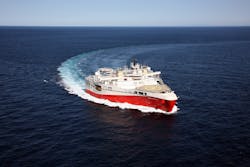Offshore staff
OSLO, Norway – Lundin Energy has contracted PGS for a 3D seismic survey over license PL1083 in the Barents Sea.
Starting in late May, PGS will simultaneously acquire sparse node and high-density multi-sensor GeoStreamer seismic for the 75-day program.
The company will deploy drop-nodes leased from Geospace Technologies with the streamer vessel Ramform Hyperion and source vessel Sanco Swift, using an ultra-wide source configuration.
Lundin’s survey polygon will cover around 3,600 sq km (1,390 sq mi) with a subset to be covered with node seismic.
PGS also revealed that it has started reprocessing around 8,000 sq km (3,089 sq mi) of 3D data west of Shetland, a region where exploration has encountered subsurface structure and stratigraphy challenges.
The company is targeting fully migrated 3D data to provide an improved and consistent regional geological perspective.
PGS MegaSurveyPlus rejuvenation project will draw on GeoStreamer multi-sensor data acquired in 2013 and 2015. The GeoStreamer component is said to add content with a high signal-to-noise ratio and a broad bandwidth into a data mix of various vintages.
Christopher Schou Watts, vice president Sales & Services, said: “New broadband reprocessing of a largely conventional dataset will help to confidently risk upcoming projects west of Shetlands.
“Advances in processing and imaging techniques, combined with increased compute power, mean that we can extract more details from the data, improve velocity models, and deliver more reliable and detailed images that will improve sub- and post-basalt imaging in general and sub-basalt assessment in particular.”
West of Shetland contains various large fields in multiple petroleum plays, with potential for near-field exploration.
One of the more promising plays is thought to be in the Flett sub-basin extending to the northeast.
According to the company, key to successful exploration and petroleum potential evaluation of the area are structural/combined trap geometry definition, use of pre-stack seismic attributes, and accurate resource assessment based on reliable subsurface data.
03/17/2021



